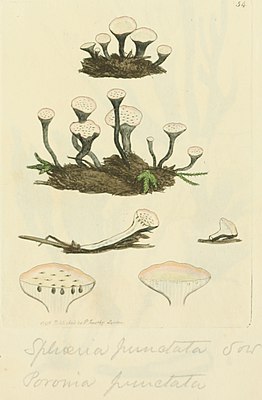Poronia punctata
| Poronia punctata | ||||||||||||
|---|---|---|---|---|---|---|---|---|---|---|---|---|

Poronia punctata , illustration from James Sowerby's Colored Figures of English Fungi or Mushrooms |
||||||||||||
| Systematics | ||||||||||||
|
||||||||||||
| Scientific name | ||||||||||||
| Poronia punctata | ||||||||||||
| ( L. ) Fr. |
Poronia punctata , sometimes also called dotted pore disk in German, is a dung-colonizing fungus from the family of wooden club relatives .
features
Macroscopic features
Poronia punctata forms a fruiting body - like, bowl-shaped or top -shaped stroma on the dung of various mammals, which have a diameter of 30–150 mm. It has a 10 to 20 mm long stalk that is usually sunk into the substrate. The outside is whitish to pale gray, the top is flat and the numerous black perithecia mouths make the top appear dotted. The actual fruiting bodies, the perithecia, are oval to egg-shaped and reach a size of 0.3 to 0.4 cm.
Microscopic features
The cylindrical, spindle-shaped asci have a strongly amyloid funnel-shaped apical apparatus , each have eight ascospores , which are arranged in two rows, and are 124–163 × 18.7–24 µm in size. The black ascospores are kidney-shaped to ellipsoidal in shape with a smooth surface. They reach a size of 20–28 × 6–10 µm.
Similar species
Poronia erici , which also occurs in Europe, can hardly be distinguished externally from Poronia punctata , which is somewhat larger, but can only be distinguished microscopically, as Poronia erici has significantly larger spores. Poronia erici has elongated elliptical spores 160–220 × 20–40 µm in size. The third hole disc described in Europe, Poronia oedipus , can be distinguished by its long stem and its disc, which is black with age. It is extremely rare in Europe and seems to be more common in Central America and the southern United States.
Distribution and ecology
Poronia punctata colonizes old dung from herbivorous mammals such as horses or donkeys, especially in calcareous areas. It is common throughout Europe, but is also known from Central America, the Indian state of Karnataka , Sri Lanka and Australia. While it was still described as common in the 19th century, it can now be classified as very rare, at least in Europe. This is attributed to the strongly intensified agriculture, as a result of which only a few horses or donkeys graze extensively on the pasture.
The red list of large mushrooms in Germany lists the species as critically endangered (endangerment category 1).
Systematics
Poronia punctata was first described by Carl von Linné as Peziza punctata in 1753 . Elias Magnus Fries then described the species in 1849 with the name that is still valid today.
Web links
Individual evidence
- ↑ 123 Mushroom Forum. Retrieved May 9, 2016 .
- ↑ a b c d Svengunnar Ryman & Ingmar Holmåsen: Mushrooms . Bernhard Thalacker Verlag, Braunschweig 1992, p. 673, ISBN 3-8781-5043-1
- ↑ a b c Matocec, N .: Nat. Croat., Vol. 9, No. 1., 35-40, 2000, Zagreb .: The endangered European species Poronia punctata (Xylariales, Ascomycotina), still alive and well in Croatia. In: Nat. Croat. tape 9 , no. 1 , 2000, pp. 35-40 ( online ).
- ↑ a b c Till R. Lohmeyer, Dieter Benkert: Poronia erici - a new kind of Xylariales (Ascomycetes) . In: Journal of Mycology . tape 54 , no. 1 , 1988, p. 93-102 ( online , PDF).
- ↑ GBIF portal. Retrieved May 9, 2016 .
- ↑ Editor: Rote Liste Zentrum: Detail page - Rote Liste. Retrieved March 29, 2020 .
- ^ Mycobank, accessed May 9, 2016